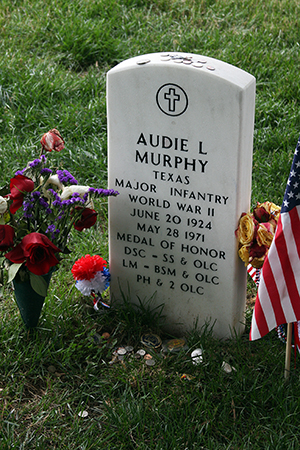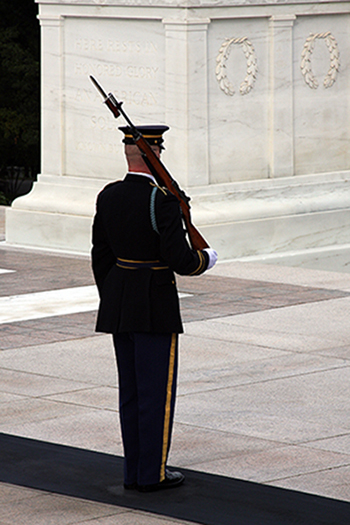Silence in the Gardens of Stone

By DAVE BERRY
A quiet pervades the cemetery.
Not "so quiet you can hear a pin drop," just comfortable, reverent silence.
Traffic noises intrude on the hush, but far away, muted, a world apart from Arlington National Cemetery's gardens of stone.
Row upon row of crosses and markers cascade over the sloping hills, their symmetry broken only by sun and shade. Final resting place for more than 400,000 active duty service members, veterans and their families, Arlington is both a national shrine and a working cemetery, hosting as many as 30 funerals per day.
Buses respectfully disgorge groups of hushed visitors as families and small groups ascend from the parking lots to the high ground. In the shaded distance, a backhoe sputters, almost apologetically, preparing another grave.
At the Tomb of the Unknowns, visitors quietly converge with murmurs and a muffled shuffling. The spatter of rain on unfurled umbrellas, for the moment, is the only sound. The visitors have come for one reason... the Changing of the Guard.

Before them, a single "Tomb Guard" of the 3rd Infantry's Old Guard, stands his watch.
Spit-shined, starched and immaculate, the stone-faced sentry faces the tomb, unaffected by the watchers, heedless of the weather. He holds steady for 21 seconds, mindful of his sacred duty, eyes on the horizon beyond the Potomac.
Then, with a practiced motion, he executes a right face and paces 21 steps. Click, click, click, click... his metal-shod heels counting off the extent of his assigned post.
Left face, eyes front, again facing the Tomb... waiting... another 21 seconds.
From along the steps comes the click of camera shutters, muffled coughs and a child's whimper shushed. Rain drips from the visor of the sentry's military cap. Blue jays argue in the wet branches overhead. The sentry pays no mind.
Noiselessly, he faces left and returns along the well-worn path to his original spot. Click, click, click, click... 21 steps, 21 seconds, the Old Guard's symbolic 21-gun salute.
Much of the cemetery's 624 acres are hidden from the sentry's view by the lush growth around the Tomb. To his left is Arlington House, the former Custis-Lee Mansion, surrounded by monuments to the Civil War's Unknowns and a newer salute to the victims of Pan Am Flight 103. A flag at half staff commands the slope leading down to the graves of the Kennedys and the Eternal Flame.
Beyond the Women in Military Service for America Memorial and Arlington's main entrance is Arlington Memorial Bridge, its span funneling traffic into the capital, around the Lincoln Memorial and on toward the National Mall.

To the right, separated from the cemetery by a busy expressway, sprawls the Pentagon, the contrast of its newly repaired wall visible after 12 years even to the untrained observer.
Far to the right, the three spires of the Air Force Memorial gleam from the crest of a hill. Directly behind it, the old Navy Annex is being demolished, providing more space for Arlington's needs.
Arlington, which this year turns 150 years old, is the final resting place for many famous names. Etched on white marble crosses and monuments throughout the grounds are Texas Medal of Honor recipient Audie Murphy, "Willie and Joe" cartoonist Bill Mauldin, astronaut "Pete" Conrad, World War I Gen. John "Black Jack" Pershing, Texas Cong. Charlie Wilson and Generals Creighton Abrams and George Patton.
Marine combat fighter ace "Pappy" Boyington is there, as is a memorial to band leader Glenn Miller, who disappeared over the English Channel on his way to entertain troops in France.
Ira Hayes, the Pima Native American Marine corporal who helped raise the flag on Iwo Jima, is buried at Arlington, as are Joe Lewis, the "heavyweight champion of the world," who served in a segregated Army unit during World War II, and Civil War drummer boy Johnny Clem.
The famous mix and mingle with those who might be considered "ordinary soldiers," lieutenants, sergeants, privates and boatswain's mates - no less noteworthy.
Many of the newest arrivals are laid to rest in Section 60, dedicated to those who served in Iraq, Afghanistan and America's latest wars.
Among the markers in Section 60 is that of Army Ranger Capt. Russell Rippetoe, of Colorado, killed in 2003 by a checkpoint suicide bombing near the Hadithah Dam. He was the first soldier killed in Operation Iraqi Freedom to be buried at Arlington National Cemetery.
Marine Corporal Patrick Nixon of Tennessee was one of 10 Marines killed in 2004 in a friendly fire incident that wounded another 17 near An Nasiriyah, Iraq.

Barbara Heald, 60, of Falls Church, Virginia, qualified twice to be buried in Arlington. A former Air Force captain, she returned to serve her country after 9-11 as a civilian Department of Defense worker. She was killed in 2005 when an Iraqi missile hit the U.S. Embassy complex in Baghdad.
Iowa National Guard Command Sergeant Major Marilyn L. Gabbard, 46, was killed in 2007 in the crash of a UH-60 Black Hawk helicopter in Baghdad.
Representing those who have fallen during the 12-plus years of America's War in Afghanistan, are two soldiers of the 10th Mountain Division, who died together when their vehicle was attacked with an improvised explosive device in Wardak Province.
Specialist Daniel L. Cox, 23, of Parsons, Kansas, and Staff Sergeant Nekl "Nick" Allen, 29, of Rochester, New York, were killed Sept. 12, 2009. Allen, a father of three, was on his third deployment, have served twice in Iraq. He had argued his sister Rana out of enlisting because, he said, it was "too dangerous."
Section 60 may be off the regular path of tourists, but families of the newly fallen visit often. Graves there are decorated with balloons, streamers and letters, a sharp contrast to the clean rows of white crosses that dominate most of Arlington.
In Section 60, the silence is different, tinged with sadness and a ragged sense of loss. Family members hold each other, children bring flowers and uniformed survivors leave mementoes for friends.
As the light fades, three rifle volleys fired over a grave and the bugle call of "Taps" signal the near-end of the day's final burial.
"Put out the lights. Go to sleep..." the lonesome 24 notes drift over the slopes.
Soon, with visitors gone for the night, squirrels will scamper past graves yet to settle, blue jays will end their quarrels and shadows creep over the cemetery.
On the heights, at the Tomb of the Unknowns, a new Tomb Guard walks his post.
Click, click, click, click... 21 steps, 21 seconds, 21 steps. This time, he walks alone into the night.
Silence descends once more on the gardens of stone.
###
Dave Berry is the retired editor of the Tyler (TX) Morning Telegraph. This article ran May 26, 2014, as a special Memorial Day salute.
Photos: Tomb guards of the 3rd Infantry's Old Guard stands watch over Arlington National Cemetery's Tomb of the Unknowns. Audie Murphy's grave occupies a prime spot near the amphitheater.
